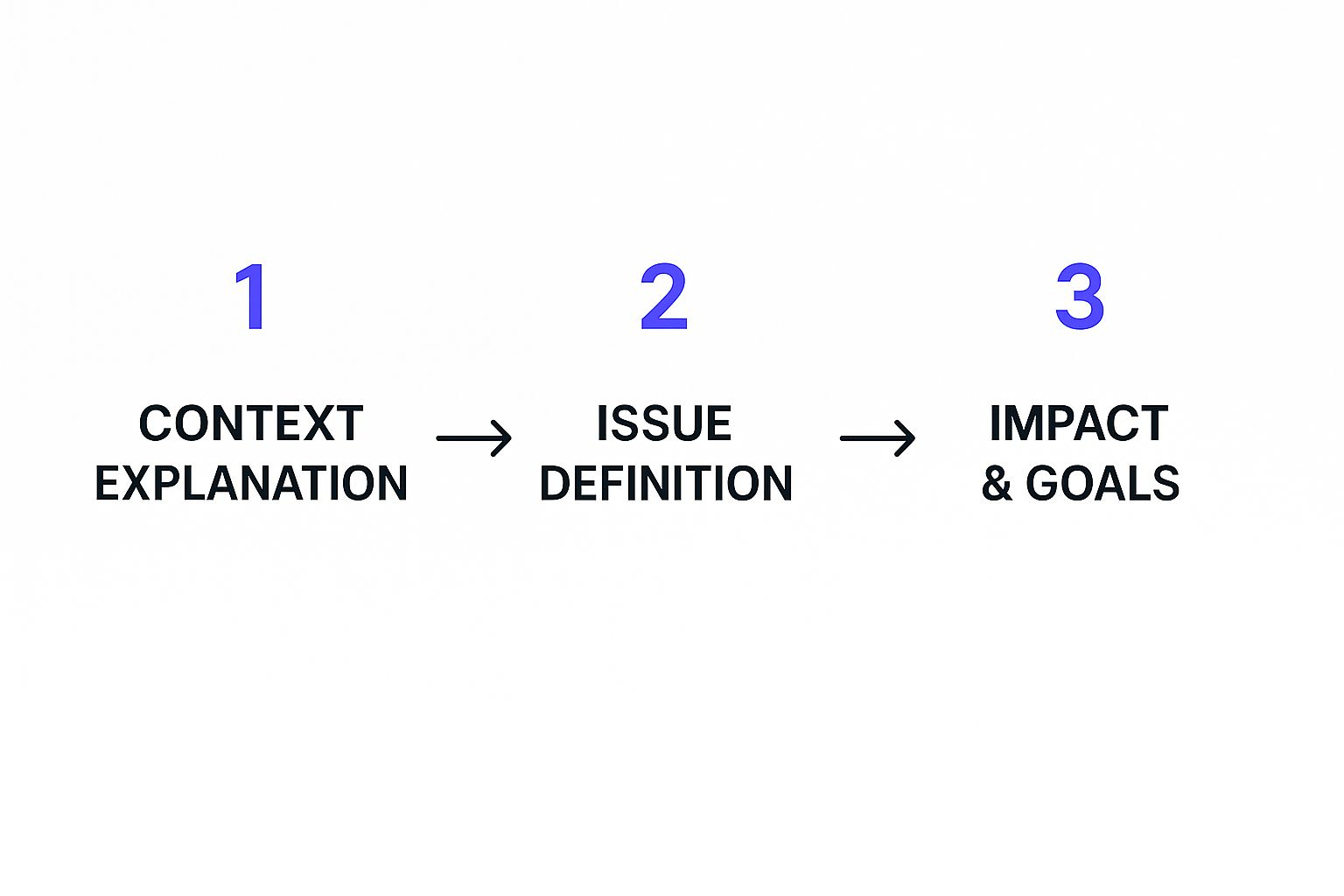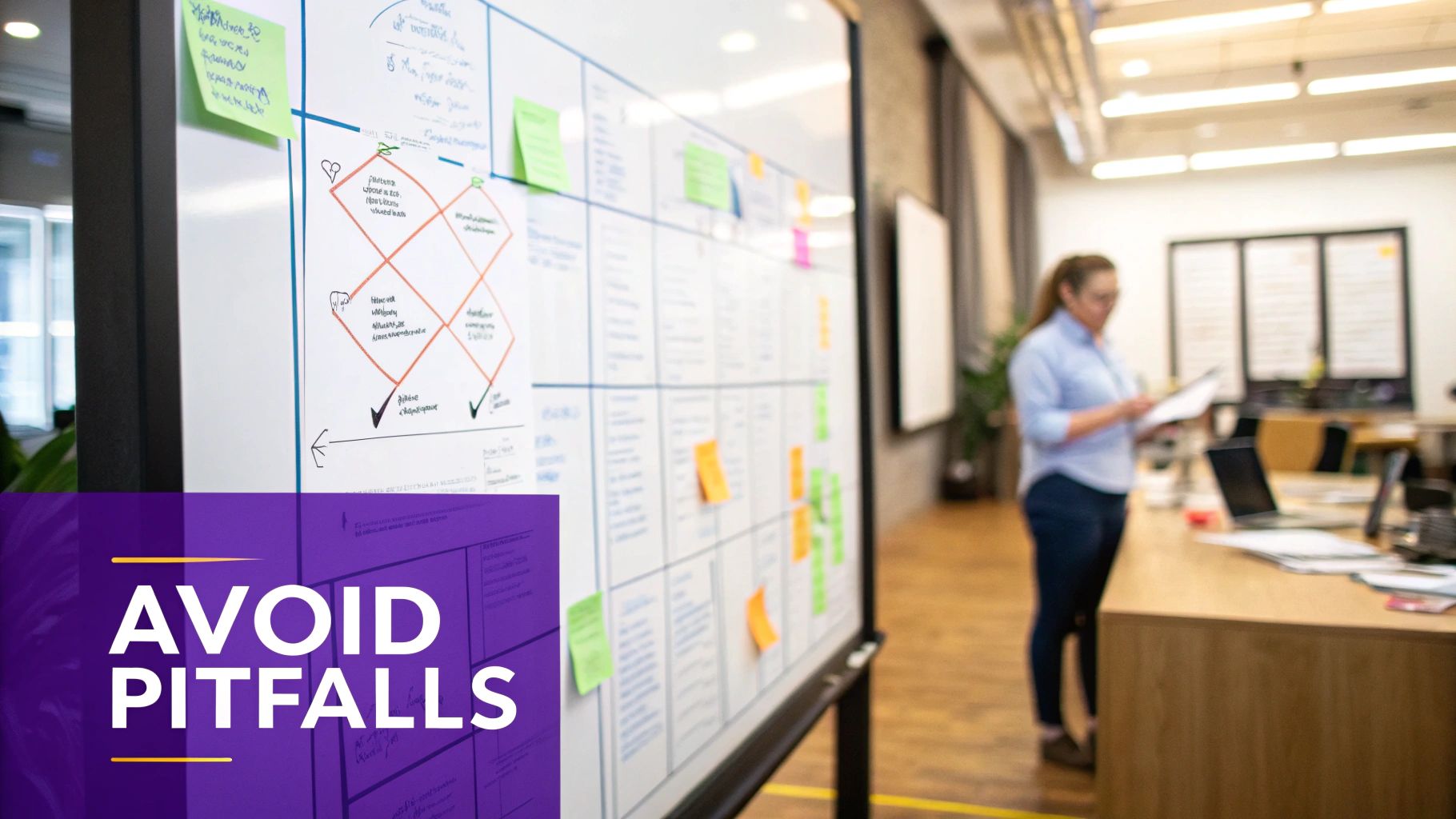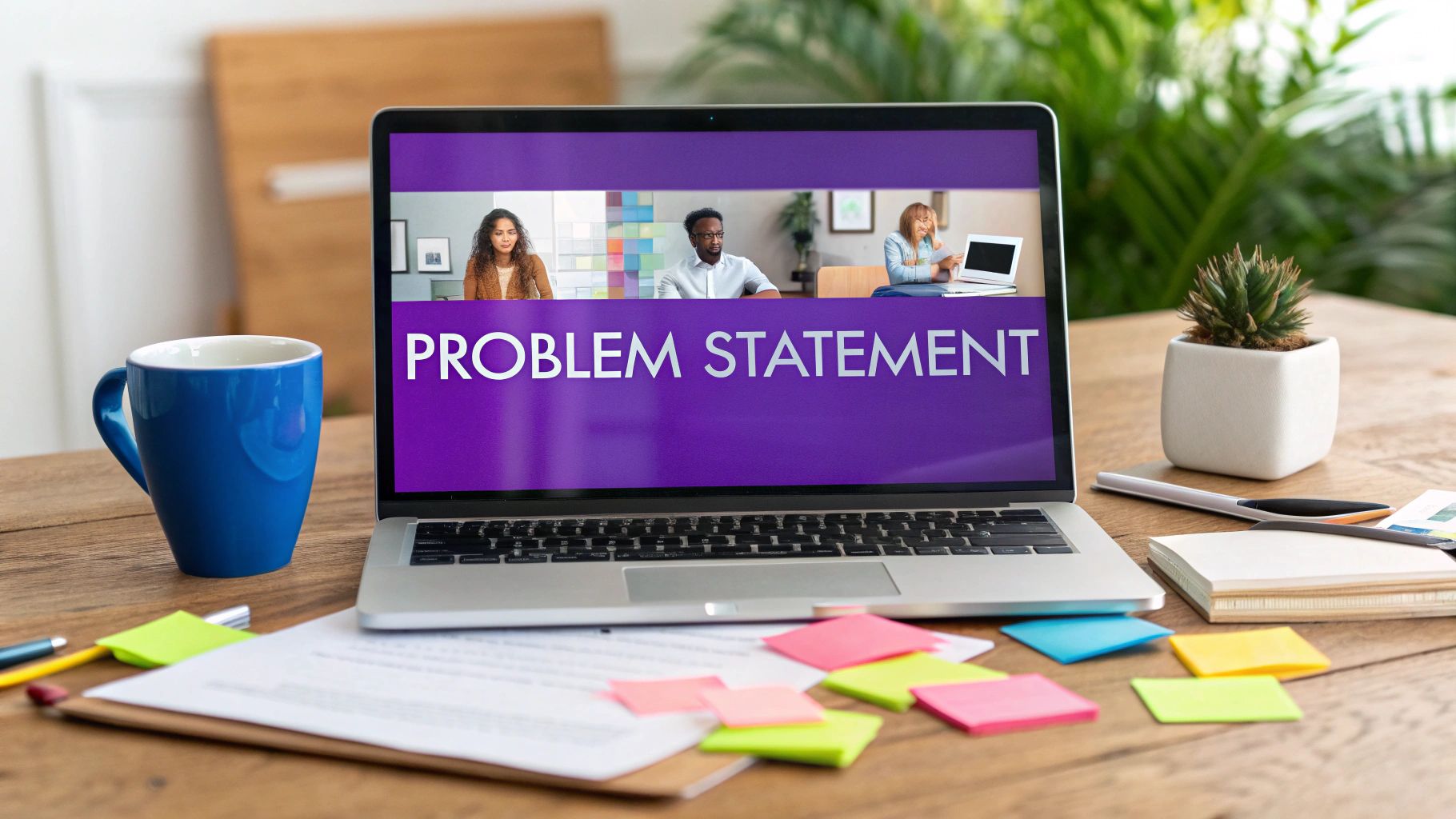Writing a good problem statement is about one thing: clearly and concisely describing an issue that needs fixing. Think of it as defining the gap between where things are now (the current state) and where you want them to be (the desired state). This simple act is what keeps your team focused on the real user struggle, not just jumping to the first solution that comes to mind.
Why a Clear Problem Statement Is Your Project’s North Star

Have you ever been on a project that spiraled out of control? The kind that burns through time and money, only to realize you’ve been solving the wrong issue all along? This happens way more than you'd think, and it almost always starts with a vague or misguided problem definition. A problem statement isn't just a formality—it’s the strategic compass for your entire team.
Let's take a real-world example. A software team sees low engagement on their new dashboard. Their first instinct? Redesign it. They spend a month tweaking colors and adding flashy widgets, but engagement drops even further. The real issue wasn't the look of the dashboard; it was that users couldn't find the specific data they needed to do their jobs. The team treated a symptom, not the root cause. A solid problem statement would have saved them from this mess.
The Compass for Remote Collaboration
For remote teams, a crystal-clear problem statement is even more essential. When you’re not sharing a physical office, misunderstandings and misalignments can quietly derail a project. A powerful problem statement creates a single source of truth, aligning everyone—from engineers in different time zones to marketers on another continent—on one unambiguous goal.
This alignment is your best defense against scope creep, one of the biggest project killers. With a clearly defined problem, it's so much easier to vet new ideas. You can just ask a simple question: "Does this feature directly help us solve the problem we defined?" If the answer is no, you can confidently table it for later. This discipline is what keeps projects on track and on budget.
A problem statement isn't just about what you're doing; it's about why you're doing it. It turns a fuzzy objective like "improve the user experience" into an actionable mission like "reduce user onboarding time because new users are abandoning the process at a critical step."
From Vague Idea to Actionable Problem
It’s easy to start with a solution in mind. We're all wired to fix things. The key is to rewind and focus on the "why" before the "how." The table below shows how to shift your thinking from a solution-first mindset to a problem-first one.
| Vague Statement (What to Avoid) | Effective Statement (What to Aim For) |
|---|---|
| "We need to build a mobile app." | "Our on-the-go sales team lacks real-time access to customer data, causing delays in closing deals and a 15% lower follow-up rate compared to their in-office peers." |
| "Let's redesign the website." | "Our website's bounce rate for first-time visitors has increased by 40% in the last quarter because the navigation is confusing and key information is hard to find." |
| "We should add a gamification feature to the learning platform." | "New user retention drops by 60% after the first week because the initial learning curve feels overwhelming and lacks clear motivation to continue." |
See the difference? The statements on the right are specific, user-centric, and measurable. They give a team a clear target to aim for, sparking much better and more creative solutions than the vague ideas on the left.
From Wasted Effort to Focused Impact
Seriously, investing an hour upfront to nail down your problem statement can save you weeks of rework down the line. It’s a small time investment with a massive return. In fact, some studies show that well-defined problem statements can increase project success rates by up to 70%. Organizations that get this right are 50% more likely to avoid those costly project failures because they’re targeting the right issues from day one. You can explore more on how to write a problem statement that drives results.
Ultimately, a strong problem statement makes sure your team’s hard work actually translates into meaningful impact. It keeps everyone pulling in the same direction, even when they’re hundreds of miles apart.
Gathering Your Raw Materials Before You Write
You can't just sit down and write a brilliant problem statement out of thin air. Before you even think about putting words on a page, you have to do some digging. Think of it as detective work—you’re collecting the clues that will lead you to the real problem.
A problem statement built on assumptions is a house of cards. It'll collapse the second you start building on it. To avoid that, you need to get your hands on the raw materials: the facts, frustrations, and candid feedback that will form the bedrock of your work.
Talk to the People on the Front Lines
The most valuable insights you'll ever get won't come from a spreadsheet. They come from real conversations with the people who are actually living with the problem, day in and day out. This is where stakeholder interviews become your best friend, but only if you do them right.
When you get time with someone, whether it's on a call or in person, your goal is to listen, not to lead. Resist the urge to ask something like, "Wouldn't a new dashboard be better?" That just confirms your own bias. Instead, ask open-ended questions that get them talking.
Try a few of these to get the ball rolling:
- "Can you walk me through how you currently handle [the process]?"
- "What's the most frustrating part of your workday?"
- "If you had a magic wand and could fix one thing about this, what would it be?"
- "If we actually solved this, what would that unlock for you and your team?"
Questions like these get you to the human side of the problem, which is what makes a problem statement feel real and urgent.
Find the Digital Breadcrumbs
People are talking about their problems all the time—you just have to know where to look. Your digital channels are overflowing with unfiltered feedback.
Comb through customer support tickets. Read your app store reviews (especially the bad ones). See what people are saying in social media comments. If you have them, watch a few user session recordings. These are goldmines. A recurring complaint or a detailed one-star review is a massive signal pointing you toward a real point of friction. For remote teams, this kind of asynchronous digging is super efficient.
Pro Tip: Create a central spot for everything you find. A shared Miro board or a dedicated Slack channel can become your "problem hub." This is where you can dump interview notes, screenshots, and powerful quotes so the whole team is working from the same set of facts.
Doing this homework really pays off. A 2023 report found that teams who dig deep into data and stakeholder interviews first see a 40% increase in solution effectiveness. Why? Because they're not just treating symptoms; they're getting to the root cause. You can find more insights about problem statement effectiveness on mural.co.
By gathering these raw materials, you're doing more than just prep work. You're making sure the problem you decide to tackle is the right one. This upfront investment of time and curiosity is what separates a fuzzy, useless statement from one that genuinely points your team toward a solution that matters.
Structuring Your Problem Statement for Maximum Clarity

A powerful problem statement isn’t some long, complicated report. It’s a lean, focused narrative that gets everyone on the same page. I’ve found the best way to write them isn't with a rigid template, but with a flexible framework built on three core parts: Context, the Gap, and the Impact.
Think of it like telling a short, compelling story. You set the scene, introduce the conflict, and then explain why it all matters. This structure is magic—it turns a vague complaint into a clear, actionable challenge your team can actually get behind.
Set the Scene with Context
First, you need to paint a picture of the ideal state. The Context describes how things should be working. This isn't about daydreaming; it’s about defining the successful, efficient reality your users, customers, or team members expect.
For example, if you're working on a fintech app, the ideal context might be something like this: "Our users should be able to fly through the onboarding process and verify their identity in under three minutes, giving them immediate access to their accounts."
This opening statement anchors everyone. It gives your team a clear vision of the target, which makes the problem you're about to introduce much easier to grasp.
Articulate the Gap
Next, you introduce the problem itself—the Gap. This is the obstacle, the friction, the thing that’s stopping that ideal state from happening. This is where you need to get specific about what’s broken. Be direct and, if you have it, let the data do the talking.
Building on our fintech example, the gap could be: "However, our analytics show that 45% of new users are dropping off at the identity verification step. We’re also hearing from user feedback that the process is confusing and often fails, causing a ton of frustration."
This part clearly identifies the "what" and "where" of the issue. It slams the door on the ideal world and brings everyone into the harsh reality, pinpointing the exact point of failure.
The goal is to make the gap so clear that anyone reading it can immediately get the core conflict. It’s the "but" or "however" that signals the shift from how things should be to how they actually are.
Define the Impact
Finally, you have to explain why this gap actually matters. The Impact connects the problem to real business or user consequences. This is the "so what?" of your statement. What's the real cost if you do nothing?
Whenever you can, put a number on it. Is it lost revenue? Spiking support costs? User churn? Wasted time?
To wrap up our fintech scenario, the impact would be: "This high abandonment rate is killing our user acquisition, costing us an estimated $50,000 in potential monthly recurring revenue. It’s also driving up our customer acquisition cost by 20%."
This final piece creates urgency and makes it a no-brainer to dedicate resources to solving the problem. It answers the inevitable "why should we care?" question before it's even asked.
By weaving these three elements together, you create a complete and compelling story that’s impossible to ignore. This structured approach is fundamental to the entire creative problem solving process, as it guarantees you’re starting with a rock-solid foundation.
Using the 5 Whys to Uncover the Real Problem
It's so easy to mistake a symptom for the actual disease. I've seen it happen countless times. Teams jump on what looks like the problem, but they're really just putting a band-aid on a much deeper issue. The biggest trap in writing problem statements is focusing on the surface instead of digging in.
A deceptively simple but powerful tool I always come back to is the 5 Whys technique.
This isn't about literally asking "why" five times and calling it a day. The real goal is to keep peeling back the layers of an issue until you hit bedrock—the one core thing that, if you fixed it, would stop the whole domino effect from happening again.
From Surface Symptom to Root Cause
Let's use a real-world example. Imagine your team sees a sudden 25% drop in website engagement. The immediate reaction? "Users aren’t clicking the call-to-action button!" But that’s just a symptom.
Here’s how you can use the 5 Whys to get to the truth:
- Why aren't users clicking the button? Because they aren’t scrolling far enough down the page to even see it.
- Why aren’t they scrolling? Because the content above the fold is boring and doesn't grab their attention.
- Why isn’t the content compelling? Because the headline and first few sentences don't clearly explain what we do or why they should care.
- Why is our value proposition unclear? Because we tried to cram every single feature into the message, and now it's just a confusing mess.
- Why did we cram so many features in? Because we haven't actually agreed on the single most important benefit for this audience.
Boom. Suddenly, the problem isn't about button placement or color. It's about a complete lack of strategic clarity. The conversation shifts from a minor UI tweak to a critical strategic discussion, which is exactly where it needs to be. This is how you write problem statements that lead to real solutions.
Running a 5 Whys Session Remotely
This exercise is perfect for remote teams. You can easily run it on a collaborative whiteboard like Miro or even just a shared document. The trick is to make it visual so everyone can see the chain of logic unfolding in real-time.
By visually mapping out each "why," you build a shared understanding of how deep the problem really goes. It stops the team from defaulting to the easiest, most obvious fixes and forces a more analytical approach.
This process helps you nail the core steps of defining a problem, which is what the 5 Whys is all about.

As you can see, defining the issue is the crucial bridge between understanding the context and measuring the impact. The 5 Whys is the engine that gets you there. Once you’ve pinpointed that root cause, you can start thinking about solutions.
This naturally leads to the next phase of the process. After digging deep to find the problem, you'll need to narrow down the best way to solve it. You can learn more about that by exploring our guide on what is convergent thinking. It’s the perfect follow-up for once your team has uncovered the true problem and is ready to decide on the best path forward.
Refining and Pressure-Testing Your Problem Statement
Your first draft is just the starting line. I've found that a truly powerful problem statement isn't written in a vacuum; it’s hammered into shape through team collaboration and a healthy dose of constructive criticism. Getting from a decent draft to a rock-solid final version means getting the team together to really kick the tires.
This isn’t about poking holes or finding fault. It’s about strengthening clarity and making sure everyone is on the exact same page. For remote teams, this step is non-negotiable for alignment. A quick, focused workshop in a tool like Bulby can turn what could be a messy review into a productive, guided session.
Hosting a Constructive Review
The whole point of this meeting is to make sure the problem statement is airtight before you sink a single minute of development time into it. Every single person on the team should be able to read it and walk away with the exact same understanding. If there’s even a hint of ambiguity, now is the time to smooth it out.
Don't just ask, "Does this look okay?" Guide the conversation with a checklist of pointed questions. These prompts force everyone to look at the statement from different angles, pushing past a simple "looks good to me." This is a key part of any structured problem solving process because it heads off so much confusion down the road.
A few questions I always ask my teams are:
- Is this statement 100% free of solutions? It must only describe the what, not hint at the how.
- Is it laser-focused on a single, clear issue? Tackling too much at once is a classic recipe for disaster.
- Can we actually measure the impact? A vague goal like "improves user happiness" is weak. "Reduces churn by 15%" is a target you can hit.
- Does everyone here interpret this the same way? Have a few people paraphrase it in their own words. You might be surprised by the differences.
The most powerful question you can ask is: "If we solve this, will it actually matter?" This forces the team to gut-check the statement against real business goals and user needs, ensuring you’re working on something with genuine impact.
Before you finalize anything, running your draft through a quick checklist can be a game-changer. It ensures you haven't overlooked any critical details and that the statement is ready for prime time.
Problem Statement Refinement Checklist
| Checklist Question | Purpose | Example of a 'No' Answer |
|---|---|---|
| Is the problem user-centric? | Ensures the focus is on a real user need, not an internal assumption. | "Our team needs a faster way to update the database." |
| Is it specific and concise? | Avoids vague language that leads to different interpretations. | "Users are sometimes unhappy with the checkout experience." |
| Is it measurable? | Defines what success looks like with quantifiable metrics. | "We need to make the onboarding process better." |
| Is it free of proposed solutions? | Keeps the team open to all possible solutions, not just one. | "We will build a chatbot to reduce support ticket volume." |
| Is the "why" clear? | Connects the problem directly to a meaningful business or user impact. | "The login page has a high bounce rate." |
Using a simple checklist like this helps you systematically evaluate your statement, turning a subjective review into a more objective and productive exercise.
Pressure-Testing with Outside Stakeholders
Once your immediate team feels solid, it's time for the final test. Share your refined problem statement with stakeholders just outside your core group. Think of someone in sales, a customer support manager, or even a trusted, long-term client.
This is your reality check. These folks bring fresh eyes and completely different perspectives, and they'll quickly spot any internal jargon, hidden assumptions, or gaps in logic that your team has become blind to. If they can grasp the problem and its importance without needing a 10-minute explanation, you’ve nailed it.
Their feedback is gold. It ensures your problem statement isn't just well-written for your team but is universally understood across the company. This final validation builds the broader buy-in you need and cements the statement as the true north star for the entire project.
Common Questions About Writing Problem Statements

Even with a solid framework in hand, a few questions always seem to pop up when teams start putting pen to paper. I’ve seen these same hurdles trip up countless teams over the years, so let's clear them up right now.
Think of this as your go-to FAQ for keeping the process smooth and effective.
How Long Should a Problem Statement Be?
I get this one a lot. The short answer? There's no magic word count. A great problem statement usually lands somewhere between a few tight sentences and a short, punchy paragraph.
The real target here isn't length—it's clarity. Your goal is to write something anyone can read and understand in under a minute, yet it must be specific enough to lay out the context, the core issue, and why it matters.
If you find yourself writing a novel, that's a red flag. It almost always means your statement is either too complex or you're trying to tackle several problems at once. Keeping it brief forces you to focus.
Problem vs. Goal: What's the Difference?
This is a big one, and it's where many teams get tangled up. It's a critical distinction to make.
A problem statement is all about the "now." It's your diagnosis of the current pain point. It answers the question, “What’s broken?”
A goal statement, on the other hand, is about the future. It’s the vision of a better reality once the problem is gone. It answers, “What will success look like?”
You simply can't set a meaningful goal without first understanding the problem. Think of it this way: you have to identify the illness before you can prescribe the cure.
One of the cardinal rules I live by is that a problem statement must be solution-agnostic. The second you start suggesting a fix—like saying, "We need a new dashboard to see our data…"—you've contaminated the process. You've short-circuited creativity and biased your team toward one specific "how" before they've even had a chance to explore all the possibilities. Don't do it.
Seeing how this works in the real world can make all the difference. If you're looking for inspiration, checking out a range of problem statements examples can be incredibly helpful for seeing these principles in action.
Is It Okay to Change the Problem Statement Later?
Absolutely. While your problem statement acts as the project’s North Star, it shouldn't be a ball and chain. In the early stages, think of it as a living document.
If your team uncovers new information or data during the discovery phase that fundamentally shifts your understanding of the issue, you have a duty to revisit and refine it. In fact, it's a sign of a healthy, adaptable team.
Just make sure you approach any revisions with the same rigor as the initial draft. Bring your team and stakeholders back to the table to ensure everyone is aligned with the new direction. This keeps you focused on solving the right problem, not just the one you first identified.
Ready to stop guessing and start writing problem statements that actually get results? Bulby gives your remote team the structure you need to dig deep, find the root cause, and get everyone on the same page. Transform your problem-solving sessions today at Bulby.com.

